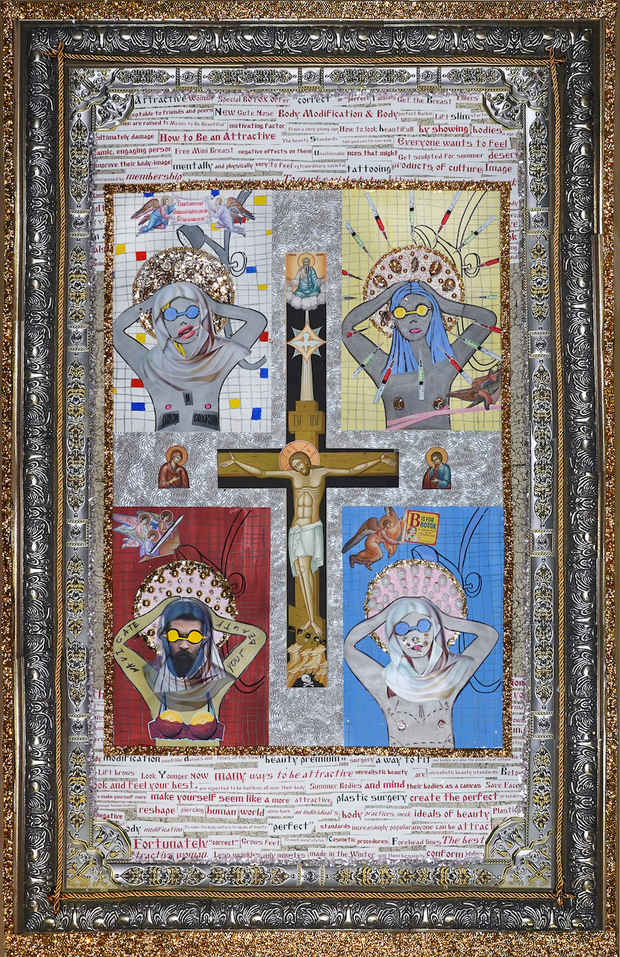Oxana Kovalchuk “Making Fools Pray to God”
Gallery 456 in Chinese-American Arts Council

This event has ended.
Chinese American Arts Council/Gallery 456 presents Making Fools Pray to God, a solo exhibition by Oxana Kovalchuk, curated by Kyoko Sato.
The Russian Icon can be traced back to 988 A.D. marking the transition when Kievan Rus’ (founded in 882 AD) converted to Orthodox Christianity. Painted on wooden supports, they depict saintly characters and holy scenarios. Their intent as ‘links’ between heaven and earth functioned as a protector bringing comfort to heart and soul.
As a student at Art School No.1 in Pavlodar, Kazakhstan, Oxana Kovalchuk (b.1979) was attracted to the myths and iconography contained in Russian and Eurasian religious annals she grew up with. However, today as New York based ex-pat since 2015, a thoroughly reborn as a ‘heretic’ artist, Kovalchuk will present her new body of work “Making Fools Pray To God”, metamorphosing Christian saints from her private arsenal into contemporary ‘deities’ venerated by the masses, people at large, under new guises. Availed of a Psychological aptitude (BA in Psychology, Omsk State University, Russia, 2001) and possessing sharp insights on the field of world economics (BA in Finance and Economy 2002), she sees that the spiritual ‘links’ today have an equivalent in the ‘realities’ provided us through iPhone, iPad, computer, or TV screens. We are surrounded by those audio-visual vicissitudes, unavoidable in our daily lives, our eyes and souls rest on them implacably for good or for bad. The place of saints was taken over by certain humans—idols and influencers have become the icons of popular culture, icons of excelsior opinion, icons of success. Perhaps a bit unwisely, obsessed believers continue making their thoughts public through their use of ‘confessional’ social mores, attracting people into their own specific sacrosanct ‘personal-cultural’. Such idols may be good or bad as it may. Ironically, a Russian proverb states, “If you make a fool to pray to God, he will roll his own head” meaning zeal without knowledge is a runaway horse.
Kovalchuk’s artistic creativity is deeply influenced by elements discovered in her experience raising three young, beloved children. She worries about their immersive exposure to the innumerable positives as well as nefarious new ‘icons’ floating un-endlessly through their screens day in and day out. In her exploration of various social media, youtube and traditional Television channels, she witnesses an array of famous characters ‘at work’, be it tech entrepreneurs such as Bill Gates, Jeff Bezos, and Mark Zuckerberg or musicians ranging from Rihanna to Lady Gaga, Ariana Grande and Billie Ellish, as well as colorful TV celebrities Kim Kardashian, Oprah Winfrey, Ellen DeGeneres and Jimmy Kimmel. Such mixed bag of characters’ social diatribes and chit chat that fuels public/private life in this Populist ‘America’, Kovalchuk produces her own abstracted icon-collages made out of layered images on independent glass panels to produce a sensation of time and space, imagery culled from those new ‘pontifical’ sources arresting them for the viewer inside Light Box formats measuring 14 x 11 inches. In a larger set of three 48 x 22 inches, the artist presents us with mixed media collages inspired by traditional Russian icons in a Hagiographic Icons aka Four-Part Icons style. The set contains, on the one hand today’s sacred icons/equivalents in ‘Healthy’ lifestyle, on the other hand, ‘Beauty’ arrives via the use of artificial, scientific procedures such as plastic surgery, topping it all off with visions portrayed in each icon panel reflective of all kinds of Covid-19 active social misconceptions. In these works, the artist is responding to today’s sensation of intense ‘fear’ due to the pandemic of Covid-19, it reeks of a repeat performance of behavioral aspects occurring in the dark Middle Ages with epidemics; echoing the fear of imminent death as portrayed in Ingmar Bergman’s 1957 film “The Seventh Seal”.
While traditional icon artists were not allowed to leave a mark of authorship except on rare occasions, think of Andrei Rublev (1360-1430, canonized in 1988), illustriously portrayed in Andrei Tarkovsky’s 1966 film about the Saint’s life—these works being considered sacramental, Holy Tools—, Kovalchuk, against the grain of history will clearly attach her name to her entire production sanctifying each work as Fine Art. Furthermore, all her icon(ic) pieces will be combined in an installation meddling modern Goth with medieval aspects enveloped by velvet curtains, posing the viewer with questions of ‘Belief’, whether this world could safely contain both positive and negative/ harmful aspects.
The installation will be interactive with the viewers exposed to an environment inspired by Christian cathedrals. In the center of the room, three church-style benches will be available for visitors to sit on and contemplate Kovalchuk’s modern day Holy Space provided with a round table rigged with votive electric candles the public can use as offerings to the new Icon/personality. A jar with paper and pen will be provided inviting visitors to share ‘live’ social media style commentary.
Media
Schedule
from March 10, 2022 to March 30, 2022
Opening Reception on 2022-03-10 from 18:00 to 20:00